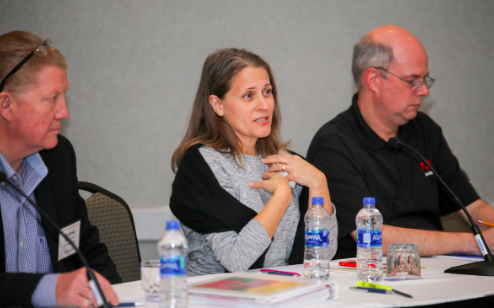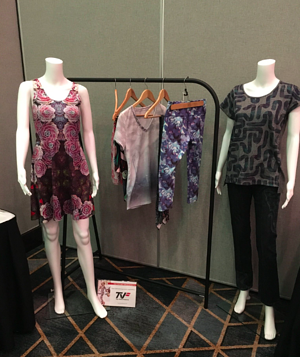Last month, AATCC and SGIA joined forces for the third consecutive year to co-produce Digital Textile Printing Conference 3.0. The event — held in Durham, North Carolina, December 5–6 — drew a mixture of suppliers, print service providers, brands, manufacturers and educators.
Tagging the conference with “A forum for collaboration ... the conversation continues,” those of us participating on the steering committee aimed to build on the previous two programs by delving into topics including digital design and workflow, color management challenges, technology advances and implementation of digital printing within the sewn product manufacturing setting.  The program was kicked off by Mark Hanley, IT Strategies, delivering an overview of digital textile printing markets, which then launched into a series of design-themed presentations addressing creative opportunities and challenges, workflow and product customization.
The program was kicked off by Mark Hanley, IT Strategies, delivering an overview of digital textile printing markets, which then launched into a series of design-themed presentations addressing creative opportunities and challenges, workflow and product customization.
Among the event's highlights was a set of panel discussions, the first of which was led by Charlotte Havle, Target Corporation, and Andrew Fraser, InMocean Group, and also included Duncan Ross, AVA CAD CAM Group, and Mike Scrutton, Adobe. Havle and Fraser spoke to the challenges for digital sampling and production in the context of a product mix that typically includes prints and coordinating solid shades that are sometimes difficult to match. Havle emphasized that today’s supply chain continues to rely on screen methods for volume production and that it’s important to improve color alignment between digital sampling and conventional production methods.
 Also speaking to color challenges, Fraser mentioned that in his experience, ink sets for digital sometimes don’t meet the specific colorfastness requirements of a given product type, such as swimwear. The sharing of such challenges was intended to spark dialogue between technology developers, suppliers, service providers and brands, and this session provided a short, yet robust exchange.
Also speaking to color challenges, Fraser mentioned that in his experience, ink sets for digital sometimes don’t meet the specific colorfastness requirements of a given product type, such as swimwear. The sharing of such challenges was intended to spark dialogue between technology developers, suppliers, service providers and brands, and this session provided a short, yet robust exchange.
The next group of speakers focused on the technology and ink theme that carried over into day two. They touched on advances in printhead technology, pigment ink, fabric pretreatments and digital carpet printing. Much of the second day was spent examining the topic of digital manufacturing and integration with sewn product design and finished goods manufacturing.
 The second panel session provided an opportunity to discuss the “micro-factory” theme, bringing together Kristin Ritter, Gerber Technology; Sharon Donovich, Kornit Digital; Bill Grier, AM4U; Will Duncan, SEAMS; and Flint Davis, WeaveUp. While sharing obstacles and opportunities for domestic cut and sew production, the group touched on workforce needs: creating sewing environments that are appealing to potential workers and thinking creatively about where to find candidates. Duncan emphasized the importance of supporting staff with training and growth. Cut and sew is clearly a challenge and the chance to brainstorm seemed well received, keeping the audience engaged until the close of the program.
The second panel session provided an opportunity to discuss the “micro-factory” theme, bringing together Kristin Ritter, Gerber Technology; Sharon Donovich, Kornit Digital; Bill Grier, AM4U; Will Duncan, SEAMS; and Flint Davis, WeaveUp. While sharing obstacles and opportunities for domestic cut and sew production, the group touched on workforce needs: creating sewing environments that are appealing to potential workers and thinking creatively about where to find candidates. Duncan emphasized the importance of supporting staff with training and growth. Cut and sew is clearly a challenge and the chance to brainstorm seemed well received, keeping the audience engaged until the close of the program.
Between these interactive discussions and the many other connections I witnessed over the two days, I left Digital Textile Printing Conference 3.0 thinking that this “forum” is just getting started and I look forward to seeing the conversation continue!